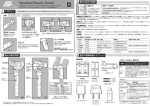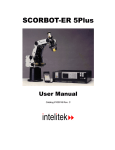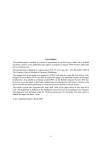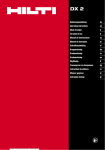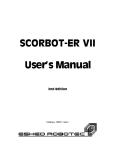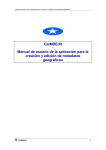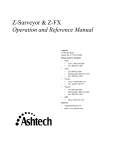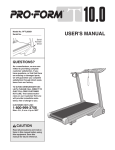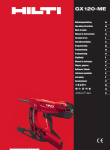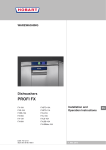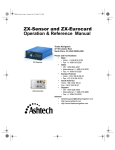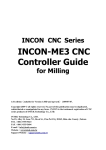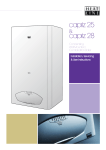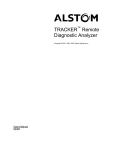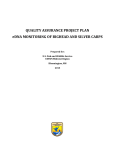Download Project Profile/Report
Transcript
Wayne County SMMS Metadata Pilot Evaluation Report May 31st, 2001 Prepared by: Orchard, Hiltz & McCliment, Inc. – Information Solutions Prepared for: The Wayne County Geographic Information Systems Management Unit as part of a grant from: The Wayne County Watershed Management Division (formerly the Rouge Program Office) 1 Table of Contents Introduction Page 3 General Analysis Page 5 General functions of the SMMS application Templates and User Defined Fields GeoConnect and the Z39.50 Protocol Metagate Recommendations for future use by the County and RPO Pricing Information Page 5 Page 5 Page 5 Page 6 Page 6 Page 7 Problems and Resolutions Page 8 Process Statistics Page 10 Import / Export Procedures Page 12 Project Data Resources Page 14 Template Recommendations Page 15 Conclusion Page 17 2 Introduction: Metadata is data that describes GIS data. Metadata tells you the Who, What, and Where of a GIS dataset. Who created it? For what purpose? When? Metadata tells you what points, lines and polygons can't show you—such as data quality, history and availability. By reading metadata, a person can answer the following: Where did it originate? What is the purpose of the data? What is the scale of the data? What steps were followed to create it? What attributes does it contain? How are the data projected? What geographic area does it cover? How do I obtain the data? Will it cost me anything? Who do I contact for more information? Metadata has been compared to the nutrition label on a food package. Without this label, you can't be sure what the food you are eating contains or whether it is good for you. In short, you don't know what you need to know to make an informed decision about the food. By the same token, without metadata, you don't know what you may need to know to make an informed decision about data use. There are three primary reasons why an organization involved in creating GIS data should care about metadata: • It's a sound solution for data management. Metadata protects the investment in data in a way that isn't possible if it's just left up to your employees to keep track of the data. Metadata also promotes data sharing and helps minimize the costs incurred by data loss or creating data that already exists. • It's the law. An executive order signed by President Clinton on April 11, 1994, mandates that all federal agencies must use the Federal Geographic Data Committee (FGDC) metadata standard to document newly created GIS data. The mandate applies to any organization that receives federal funds to create GIS data, which can include federal, state and local governments as well as private organizations using federal grant money. • It promotes the notion of data transfer. Metadata provides information to transfer data out and to process and interpret data received through a transfer from an external source such as the Wayne County (County), Rouge Program Office (RPO) or local communities. 3 The purpose of this project was two fold. The first purpose was to develop a pilot implementation of Rouge Watershed metadata within the Spatial Metadata Management System (SMMS), a product from RTSe for an explicit functional analysis to determine usefulness. Secondly, the project purpose was to establish a metadata creation and tracking solution to be used with the County, RPO and local communities data. This report provides a detailed functional evaluation of the SMMS package in terms of what data sources it can work with, data capacity and performance, as well as procedures as outlined in Appendix A – Scope of Services contained in the Rouge Watershed GIS Grant. Fourteen spatial datasets were chosen. They cover the most common types of datasets used by the County, RPO and local communities. These include point, line, and polygon ArcInfo coverage’s plus TIF formatted aerial imagery. This report represents the details of our evaluation based on the previously mentioned objectives. Some items are not yet resolved, are noted in this report and are dependant upon a continued effort by the County. These efforts may include the County contacting the RTSe support staff to resolve the open issues or continuing to have Orchard, Hiltz & McCliment, Inc.- Information Solutions (OHM-IS) work towards the solutions. 4 General Analysis: The following six functional elements regarding the software and its usability were evaluated: General functions of the SMMS application: The SMMS software supports multi-user access allowing more than one person to work on the metadata information at one time through user accounts setup in the database, which is a main concern of the County and the RPO along with the employment of a relational database model. This allows the County and RPO to compile one metadata record for each database from various sources. The SMMS application uses the relational database file structure of MS Access but can also work in an Oracle or SQL server environment. Templates and User Defined fields: The SMMS application is designed to make all FGDC fields available to the user. They also have installed the flexibility for the metadata creator to add their own fields plus the user can create a template of information for others to follow. The templates can be as complex or simple as desired. There creation is intended to build a framework to be used for other data collaborators to follow. Common information such as data quality, metadata reference and identification information can be created in one template. These templates allow the user to focus in on the dataset by not having to enter redundant information into the metadata, thus saving time and effort. Five tabs are available under the User Defined section of SMMS. They are Text, Memo, Drop down list, Date, Numeric. This section allows the user to develop custom fields of data input that are not part of a FGDC standard metadata record but are necessary to adequately document a dataset. The five tabs are explained below: Text: A generic text field that can be hyperlinked in SMMS reports. Memo: A paragraph field for recording notes or reminders associated with a dataset. Drop-down list: A multi-value field for creating dropdown lists. Date: A preformatted field for recording date values. Numeric: A preformatted field for recording numeric information. In this project no user-defined fields were created. GeoConnect and the Z39.50 search protocol: RTSe, the vendor that supports the SMMS application, has also created the SMMS GeoConnect Geodata Management Server. This application is designed for organizations where multiple users must have quick and easy intranet access to GIS holding. The easy point and click interface lets users search, preview, and share your organization’s valuable geodata archive. The search engine in this piece of software is also ANSI/NISO Z39.50 compliant. This means that it follows specifications set up by the FGDC in regards to data retrieval. For more information on this the following URL can be visited: http://www.rtseusa.com/pagetemplate/3Column-d.asp?pageid=116 The GeoConnect application was not tested in this project. 5 MetaGate: Included with every copy of the SMMS Metadata application is a small viewer utility called MetaGate. The MetaGate Data Catalog is a tool that bridges the gap between GIS data and metadata to provide a new level of access to and control over your GIS data library. Through MetaGate, metadata becomes a powerful tool for previewing GIS data. MetaGate features: • • • • Summary metadata from SMMS A map image of a dataset A Windows style tree view that allows you to quickly navigate to the record of choice using a point-and-click graphical interface. A powerful Search function that allows you to rapidly locate records according to metadata keywords, attributes, bounding coordinates and time period of content. MetaGate provides a comprehensive overview of each layer in your GIS data library. You can preview data while reading descriptive metadata from the SMMS database. If more information is needed, you can launch the complete SMMS metadata record. The MetaGate application was not tested in this project. Recommendations for future use by the County, RPO and local communities: OHM-IS recommends that the information in this project be used to build a framework for expansion of metadata management into all existing spatial datasets that are in the County, RPO and local communities archives and all future entries into said archives. An agreed upon structure of FGDC fields should be standardized and then templates can be created to distribute with the SMMS application to data providers. Metadata creation should be introduced into all contracts and enforced as a deliverable. Data that is already stored in spatial archives should have metadata created for it to keep with the consistency and use of metadata. The data archive itself needs to have an easily useable search engine so data distribution is not an issue so much as to keep users from querying and using the metadata. The future type of these search engines may include using the RSTe Metagate software or ESRI ArcCatalog software connected to an Oracle or SQL server database. The creation and distribution of metadata is a large and arduous task. Any steps to streamline any and all functions in this process can only help to ensure that accurate and useful metadata is created for all parties included. It is imperative that the process be simplified enough that the County, RPO and local communities are able to easily incorporate the creation and use of metadata into their GIS workflows. 6 Pricing Information: Listed below is a cost sheet that was sent directly from RTSe. These prices are current as of March 2001. That original document will be included as a separate document as well. All Prices in US Dollars SMMS 3oh! Desktop software: GIS data management system allows users and organizations to quickly create, manage, and publish FGDC compliant metadata. Features include templating, automatic metadata extraction, user definable fields, biological profile and publishing. Standard product stores all metadata in an Access database provided with the software. Creates searchable records in GeoConnect. Desktop seat licenses 1 2 to 9 10 to 24 25 to 50 GSA Schedule $595 575 500 490 Standard Pricing $650 630 550 530 GeoConnect Servers: Supporting multiple users with ASP Intranet and Internet query and retrieval capability, these metadata servers are designed for the organization that must support a wide workload for metadata. Also includes a Z39.50 gateway for organizations desiring to participate in FGDC clearinghouse activities. Access, Oracle and Microsoft SQL Server options are available (please specify). GeoConnect can also be hosted and served on-site at RTSe for organizations that do not wish to maintain a SQL or Oracle server. Users GeoConnect 1 2 3 GeoConnect Hosted GSA Standard $4,200 $5,000 $4,000 $4,500 $3,500 $4,000 $8,500 -- plus $150 per month hosting fee On-site Training and Consulting: $1200 per day (up to 12 students) plus travel SMMS Organizational License: A complete enterprise wide GIS management solution that can be scaled to fit your needs. Base license includes 20 desktop copies of SMMS 3oh!, the GeoConnect Server, and a day of on-site training. You can then add additional copies of SMMS 3oh! anytime for the same low price. GSA Standard Base Price $15,000 $17,500 Additional units of SMMS 3oh! 300 325 SMMS Spatial Direct: A data conversion solution for retrieving data in the format you need regardless of the format it was created in. Supports over 60 data formats. Customized pricing Please Direct All Orders To: Madeline Binkley RTSe Account Executive, Government Sales [email protected] Phone: (425) 605-1003 Fax: (425) 885-0396 http://www.rtseusa.com 7 Problems and Resolutions: The following section is a list of error messages and problems encountered during the implementation of the 14 datasets. Some of these problems have not been resolved and may need continued investigation to resolve. Problem #1: Version 3.1 of the software cannot associate ArcInfo coverage’s. The error message states: Object does not support this property or method. Resolution: Version 3.1.1 and higher does not have this problem. This fix applies to Windows 95, 98, NT and 2000 machines. Problem #2: Some of the SMMS pop up windows are truncated and cannot be resized. Resolution: This is fixed in version 3.2. Problem #3: Capturing the Direct Spatial Reference Method for the Imagery came up as Vector instead of Raster. It also did not provide the row and column pixel count information. Resolution: Viewing the image properties in the windows explorer defined these values and then was typed in manually. This is only a work around not a fix. Problem #4: Version 3.1.1 or higher are the only versions that will run on a Windows 2000 operating systems. The older versions have not been made forwards compatible to Windows 2000. When the SMMS application is upgraded then the metadata database has to be converted so it can be used with the newest version. Resolution: Start using only version 3.1.1 and any upgrade from there, if your operating system is going to be Windows 2000. Problem #5: An error happened that gave the following message when trying to get the bounding coordinates for the City of Westland Storm Pipes in version 3.1.1: After clicking the OK button the Capture Bounding Coordinates window stays open and will not close until exiting from SMMS. The window does not inhibit continuing with 8 the application. It just has to be moved to the side. Closing the application then trying to capture the coordinates again results in the same situation happening. Building the coverage in ArcInfo 8.0.2 did not solve the problem. Doing a “describe” command in ArcInfo 8.0.2 showed a legitimate set of bounding coordinates. There was nothing to be found in the SMMS online help file that described this error code. After sending the coverage to RTSe tech support they could not associate the coverage in SMMS or read it in ArcView 3.1 at their office. The coverage could be read at OHM-IS in ArcView 3.2a. I was advised to wait for the next upgrade from RTSe. After upgrading to version 3.2 the following error message shows up in the Association Section for the City of Westland Pipes. The data had shown the actual locations in version 3.1.1. Now the error message is the only thing that shows up in this screen. The coverage was converted to a shape file in ArcView 3.2a then an associate with that shape file was made in SMMS to get the bounding coordinates. The bounding coordinates came out as all zeros. This new error message information was passed on to RTSe tech support. The bounding coordinates have been added by duplicating the other Westland dataset bounding coordinate values. Tech support from RTSe asked for a copy of the City of Westland Storm Pipes coverage and the City of Westland Storm Inlets. They wanted to see both a coverage that was not working and a coverage that was working. This would help to compare and contrast the two while testing. Both coverages were sent. Resolution: None yet. Matt Darby is the technical support contact from RTSe that is handling this incident. Email can be sent to him at the following address: [email protected] Problem #6: The bounding coordinates for all of the Quality Sampling Site datasets come through as zero for each side. No error message comes up like was seen with the City of Westland Storm Pipes. Building the coverage in ArcInfo 8.0.2 did not solve the problem. Doing a “describe” command in ArcInfo 8.0.2 showed a legitimate set of bounding coordinates. Resolution: The bounding coordinates have been added by using the values that were found in ArcInfo when using a “describe” command. This is only a work around not a fix. 9 Process Statistics: 14 separate datasets were imported. Dataset Name Description # of Records Size in KB Type of Features Import Time (in seconds) Detbas Subareas Sample95 Sample96 Sample97 Sample98 Sample99 Hydroline Hydropoly Streetscl 797984.tif Catch Inlets Pipes Detention Basins Watershed Subareas Quality Sampling Sites 1995 Quality Sampling Sites 1996 Quality Sampling Sites 1997 Quality Sampling Sites 1998 Quality Sampling Sites 1999 County Hydrolines County Hydropolys County Centerlines County Ortho Photo Storm Catchbasins Storm Inlets Storm Pipes 21 19 4 4 4 4 4 25,743 4,352 89,397 0 4,946 2,125 15,210 2,390 16,515 595 595 595 595 595 11,331,678 12,488,244 67,070,884 34,598,626 521 224 2,821,456 Points Polygons Points Points Points Points Points Lines Polygons Lines Pixels Points Points Lines 7 8 6 6 6 6 6 13 12 21 16 8 7 7 Note: All datasets were processed on a Pentium III 700 MHz processor under Windows 2000. The completed MS Access database file with all completed metadata records is 1,333,248 KB. ArcInfo coverage’s take longer to associate than ArcView shape files do. It may be advisable to convert ArcInfo coverage’s into ArcView shape files to save time. ArcSDE (spatial database engine) layers were not tested in this project. When using the Capture data buttons, that are located in different areas of the SMMS application, they take the same amount of time to complete their task as it does for the Association of Data button to complete. These buttons perform the same function. There is a delay after clicking on the Capture button before you see any kind of message that tells you that the collection has started. The cursor does not change either, it should be noted to users not to believe the SMMS application has failed or locked up since some of these functions can take some time. There is a need to do multiple entries of the same data for common datasets. A copy and paste function can work for some. Creating a text file in WordPad or Notepad and leaving it open on the desktop can help ease this situation. This allows you a global list of information that can be used to copy and paste commonly repeated text within the SMMS application. This is of course above and beyond what a template can do. This remedy helps when no template is available. The Thesauri/Keyword Admin tool is very helpful in creating a data warehouse of keyword information that can be accessed via the dropdown list box of the appropriate thesaurus. A set of thesauri can be created and exported to other users to use as a form of quality control or input. 10 The SMMS application has a multifunctional help system. It allows you to ask for the SMMS definition of a field or the FGDC definition. The FGDC version is more in depth and can also include examples. These examples are helpful since most of the FGDC structure was written for the advanced metadata user. The examples help translate this federal code into a more userfriendly verbiage. It also provides useful examples from other metadata sets. A typical entry text box visually truncates data until the user clicks on the text box. Double clicking on a typical entry text box will bring up a larger text box that is expanded for easier text editing and entry. A single click places the cursor in the text box and then displays the up and down scrolling arrows for the user use in navigating the text box.. RTSe tech support has responded to each email that has have sent before the close of business that day. They are proactive and want to help. They are professional and useful. When an updated version of SMMS is released you have to uninstall the current version on your computer before you can install the upgrade. The MS Access database is not deleted during the uninstall process. Once you install the upgrade then you have to run your current database through a database upgrade utility that comes with each SMMS upgrade. The database upgrade utility does convert databases from the last 3 versions into the current version. This becomes important if you decide not to upgrade right away. Your database may not be upgradeable after a while. There has never been a cost for any of the 4 upgrades that were released during this project. 11 Import / Export Procedures: Trying to nail down a precise step-by-step procedure is difficult when dealing with metadata. This is due to the fact that many intricate pieces of data have to be filled in as information comes to you. Listed below is a good starting point that can help the metadata technician from having to repeat work and build a consistent input flow. 1. 2. 3. 4. 5. 6. Create a new metadata record for the dataset and name it. Complete the citation for the new record. Associate the metadata record to the geographic dataset using the Associate Data section. Confirm the correct information that was collected from the association done in step 3. Setup your Keywords and Thesaurus Return to the Identification section and continue. SMMS metadata can be imported / exported into the following different file formats: • • • • Export from SMMS: SMMS Encoded Format (*.sef) FGDC Encoded ASCII (*.txt) FGDC Encoded SGML (*.sgm) • • • • • Import into SMMS: SMMS Encoded Format (*.sef) FGDC Encoded ASCII (*.txt) FGDC Encoded SGML (*.sgm) Ordered XML (*.xml) To import your SMMS metadata record into ArcInfo 8.0.2 you must export the record into the FGDC Encoded Ascii format or FGDC Encoded SGML from SMMS. Then it can be imported into ArcCatalog 8.0.2. ArcCatalog 8.0.2 allows you to edit the metadata with a user interface that looks similar to the SMMS application. Any metadata in ArcCatalog 8.0.2 can be imported / exported into the following different formats: • • • • • • • Export from ArcCatalog: FGDC CSDGM (FAQ) FGDC CSDGM (HTML) FGDC CSDGM (SGML) FGDC CSDGM (TXT) FGDC CSDGM (XML) HTML 12 • • • • Import into ArcCatalog: FGDC CSDGM (SGML) FGDC CSDGM (TXT) FGDC CSDGM (XML) Using the metadata section of ArcCatalog 8.0.2 it has been noted to run very quickly and presents no know problems. It was tested with 10 datasets. Data was exported from SMMS and imported into ArcCatalog 8.0.2, edited and then exported. The files were then imported into SMMS. Multiple formats were mixed and matched. None caused any problems or delays during the testing. There was no loss or change of data. No testing was done into the issues of importing metadata into ArcIMS (internet map server). 13 Project Data Sources: The “Wayne County, Michigan Photogrammetric Database Design” as well as Section 6 of the RFP for “Photogammetric Mapping Services for Wayne County”, The “Michigan Geographic Framework” Version 1.0 Field Definitions and Final Report GPS Survey June 1999 were used to collect information about the attributes, accuracy and information relative to the following datasets. • • • • Hydrolines Hydropolys Centerlines Ortho Photos The “Rouge River National Wet Weather Demonstration Project GIS Data Dictionary” as well as the “Rouge River National Wet Weather Demonstration Project GIS Standard Operation Procedures Manual” was used to collect information about the attributes, accuracy and information relative to the following datasets. • • • Detention Basins Watershed Subareas Quality Sampling Sites 1995 thru 1999 Internal OHM-IS project documentation was used to collect information about the attributes, accuracy and information in general about the datasets along with information from the City of Westland. • • • Storm Catchbasins Storm Inlets Storm Pipes 14 Template Recommendations: The creation of a set of templates for the County, RPO and local communities will be essential in making sure that any and all metadata supplied to or from the County is consistent and correct. A set of guidelines will have to be created, shown and demonstrated to any and all metadata creators that plan to submit their metadata to Wayne County. The following template recommendations are meant as a guideline for metadata creation both internal and external to the County. The recommendations are broken down by section as they are in the SMMS application. The information fields listed below are the fields of data that can be filled in prior to the dataset being associated to the metadata record in the SMMS application. This means that some fields cannot be include in a template since they are dependent on the association function to fill in unique spatial information. These sections are truly subsections of a metadata set and can be created before any other metadata is created. These sections are more of a policy issue then being actual data. • • • • Citation List Contact List Distribution List Thesauri / Keyword Administration These sections are the heart of the metadata itself. Some can be created in a template and the association of the spatial data to the metadata record fills others in. Listed below are the fields that can be best utilized in a template. Identification General Tab Access Constraints Use Constraints Data Set Credit Native Data Set Environment Keywords Tab Theme sub tab Place sub tab Security Tab Security Classification System Security Classification Security Handling Description Data Quality General Tab Logical Consistency Report Completeness Report Attribute Accuracy Tab Attribute Accuracy Report Horizontal Positional Accuracy Tab Horizontal Positional Accuracy Report Process Steps Tab Process Description Process Date 15 Process Contact Spatial Reference Horizontal Coordinate System Tab Planar Coordinate Information sub tab Geodetic Model Tab Horizontal Datum Name Entity and Attribute General Tab Entity and Attribute Overview Entity and Attribute Detail Citation Entity Label Entity Definition Entity Definition Source Metadata Reference General Tab Contact Metadata Security Classification System Security Classification Metadata Security Handling Description Metadata Access Constraints Metadata Use Constraints Metadata Standard Name Metadata Standard Version Metadata Time Convention User Defined These will be handled in accordance to the fields that are created. 16 Conclusion: The evaluation report along with the actual metadata database created in this project will provide a basis for the County, RPO and local communities to continue to make strides to implement a comprehensive metadata archive. This database will be able to meet all current needs as well as be flexible enough to expand to meet any future needs that are required of it. OHM-IS recommends the creation of templates as described in the previous section before the full implementation of this metadata tool. This could be done as part of a follow-up project using an expanded list of datasets from the County and several of the communities within the Rouge watershed. 17 Appendix A - Metadata Tool Functionality Matrix Tool Name Vendor Contact Phone Address City, State, Zip Reference Sites Cost Import Functions Access dB SGML Text ABI HTML SUTRS MARC Oracle MS SQL Export Functions Access dB SGML Text ABI HTML mp (CSDGM) MetaLite Multiple Formats Compliance CSDGM OGRIP Compiler User Interface Simple OSF Motif Windows Menus Lists Modal (required) Entry Repeatable Cut/Past Copy/Paste Incremental Update On-Line Help Windows Based Help Spell Checker Dictionary Modifiable Misc. Requirements History File Y2K Compliant Administration Platforms Install Ease Dependencies Future Changes / Additions Rating Rating Rating Rating Rating Spatial Meta Data Management System Enabling Technologies J.D.Optekar 425-793-6261 15 South Grady Way, Suite 634 Renton, WA 98055 Metadata Manager Blue Angel Technologies [email protected] 1220 Valley Forge Road P.O. Box 987 Valley Forge, PA 19482 MetaLite - Version 2.7 U.S. Fish and Wildlife Service Jay Johnson 907-786-3422 1011 East Tudor Road Anchorage, Alaska 99503 Washington DOT Gordon Kennedy (360)705-7641 [email protected] 3-4 Users US National Guard Brian Hall (435)797-4157 [email protected] Several 100 Users $595.00 1 X X X O O O O FUTURE X 1 X X X O X O O X 1 X X 1 X O O X X X O X X X X X X X X 1 ? X • American Heart Association • Census Bureau • Colorado Department of Natural Resources [email protected] [email protected] No contacts provided $1995.00 CSDGM only 2 X X ? X O O O O O 2 O X ? X X O O X 2 X O 1 X O O X X X O X X X X X X ? ? 1 ? X Free from FGDC website or Free-http://edcnts2.cr.usgs.gov/ MetaLite/MetaLite.htm 3 O O X O O O O O O 3 O O X O O X X O 1 X X 2 X X X X X X X X O O X X O O X 2 O not verified Rating NT, WIN95 X Stand Alone ORACLE Support Win95, NT X Stand Alone None Announced NT/UNIX X ARC/INFO Map for choosing the bound coord Color coding of field requirements Import Functions Improved Interface Inclusion of ISO Standard APPENDIX B – Product Descriptions Brief Product Review – Spatial Metadata Management System (SMMS) – Option 1 Name/Version: Version 2.0 of SMMS Function: SMMS is a stand-alone metadata capture, creation, management, and publishing tool that utilizes a relational database for storing the metadata. Obtaining Software: Public trail-ware download available from (or request a CD): http://www.enabletech.com. Transfer size of software: 26 MB, Installed size of software client: 30 MB Version 2.0 of SMMS meets the revised Version 2.0 of the FGDC standard. SMMS 2.0 supports both MS Access 97 and SQL Server 6.5 as the relational database that can be utilized for storing the metadata. Features of SMMS 2.0 include: ability to import FGDC compliant metadata in text or SGML format; ability to setup templates for metadata development; ability to reuse contacts, citations, and distribution methods from pick-lists; extensive online help for FGDC definitions; enhanced security for multi-user metadata development environments; simple searching based on keywords, bounding coordinates, and time period of comment; metadata management reports (who reviews what metadata when); and publishing to text, SGML, and HTML. Supporting Information Name of supporting organization: Enabling Technology, Inc. E-mail contact: [email protected] OS: Windows '95, '98 and NT Software: Stand-alone, $595 per copy. Site Licenses are also available for organizations. Maintenance: Upgrade to Version 3.0 of SMMS available for a 10% to 20% charge of original software. Version 3.0 includes MapObjects technology for capturing metadata directly from coverages and shapefiles. Due out in mid-spring of 1999. Imports: Metadata entries in text form, Metadata entries in SGML form Exports: TEXT, SGML (ver. 2), HTML (with auto links to browse graphic and data). Access 97; Ability to use any reporting tool to develop your own reports. Documentation: Quick Start and Installation Guides in printed format and .pdf are included with SMMS 2.0. Supporting Comments ALL of the users, regional offices, and national standards participants noted the usability and completeness of the SMMS product. Although only two were willing to “recommend a product, of those two, both recommended SMMS as currently the best tool set. Brief Product Review – ARC 8.0 – Option 2 CONFIDENTAL INFORMATION COVERED UNDER NON-DISCLOSURE WITH WAYNE COUNTY PLEASE DO NOT SHARE THIS INFORMATION OUTSIDE OF THE GISMU / ESRI PROJECT OFFICES. Name/Version: ARC/INFO Version 8.0, ArcCatalog (AC) Function: ADC is a stand-alone metadata capture, creation, management, and publishing tool that utilizes a relational database for storing the metadata. Interface: The ArcCatalog is a data management and browsing application which will be used to navigate to data like Windows® Explorer and using icons, and a content panel to locate and identify data types. One of the nicest new features in the ArcCatalog is the support of dragn-drop to copy or move data sets. The ArcCatalog is made up of four components: • The “preview” which shows a preview of the dataset • The “table” which is your attribute table • The “contents” which either shows your data layers as a list or as thumbnails to view • And the “documentation” or Metadata view which is currently not implemented So the reason this is not the first choice for tools. There are ways to work around this issue and ESRI is currently performing their own evaluation on metadata tools for data capture and display. Two of the tools currently being evaluated are SMMS and Blue Angel. Spatial MetaData Management System Enabling Technologies J.D.Optekar 425-793-6261 15 South Grady Way, Suite 634 Renton, WA 98055 Blue Angel Technologies, Inc. 1220 Valley Forge Road P.O. Box 987 Valley Forge, PA 19482-0987 USA Phone: 610-917-9200 Fax: 610-917-9958 • Sales and Business Issues: [email protected] • Technical Support: [email protected] Partial Customer List • American Heart Association • Census Bureau • Colorado Department of Natural Resources Supporting Information Name of supporting organization: ESRI, Inc. e-mail contact: [email protected] OS: Windows NT Software: ARC/INFO 8.0 ArcCatalog Module Maintenance: TBD Imports: TBD Exports: TBD Documentation: TBD Brief Product Review – MetaLite – Option 3 Name/Version: MetaLite Function: Intelligent CSDGM certified FGDC Standard text, sgml and html output metadata collection tool Obtaining Software: U.S. Fish and Wildlife Service Region 7 FTP Server IP address: 164.159.151.4, username is "anonymous", password is your email address. Descend to directory Metalite. Read README file. GET the files you need for new installation or updating an existing MetaLite revision Platform: Arc/Info running on UNIX or Windows NT MetaLite is a CSDGM metadata entry tool created with Arc/Info AML language. If the dataset is declared to be an Arc/Info coverage and the coverage is online, data mining can be initiated to supply the data bounds and projection parameters, however no thematic information is extracted. Because MetaLite is not tied to Arc/Info data, it forms a generic metadata documentation tool for any geospatial data. AML was chosen for the tool development environment because of the author's familiarity with this language, because it provided the needed user interface tools, and because users at the development home for this tool (USFWS, Anchorage) all have UNIX Arc/Info available to them. As the name implies, the tool allows documentation of a subset of the metadata elements present in the CSDGM (about one third) which were deemed sufficient for FWS requirements at a national level. Metalite has been enhanced with a SGML import that can process any FGDC-compliant SGML metadata file, extracting only the "lite" subset of elements. MetaLite automatically runs mp (Metadata Parser) to generate text, SGML and HTML outputs. MetaLite has built-in connectivity to a locally installed ISITE node and can automatically add the metadata file and re-index the database. Browse image files can be automatically embedded in HTML output. Additional notes: 1. Perhaps the most significant feature is the relational-type association between metadata element values and datasets, virtually eliminating redundancy and automatically enforcing FGDC and local standards. 2. MetaLite requires Arc/Info running on a Unix workstation. Unlike other metadata collection tools, no ties are made to INFO, Arc commands and Arc coverages; only AML, some systems calls and extensive use of form menus comprise MetaLite. 3. Ease of use, form presentation clarity, minimizing key strokes are all primary design goals that effectively shield the documenter from the overwhelming complexities, known as "production rules" comprising the FGDC Standard. 4. MetaLite calls mp (Metadata Parser by Peter Schweitzer) in the final stage to perform a stringent format and validity check before creating servable Internet files. Information from one dataset can be used to initialize another, potentially reducing documentation time dramatically. 5. MetaLite is intended to serve the needs of persons documenting GIS datasets from many different GISs. Supporting Information Contact email: [email protected] The latest release of MetaLite is version 2.7 and it is available on the Fish and Wildlife Service ftp server at 164.159.151.4 in the Metalite directory. It includes both Unix and NT versions as well as installation instructions. If you are unable to contact Barry or have problems downloading the software, you may contact Jay Johnson or Jerry Minick ([email protected]) for help. Jay Johnson Computer Specialist U.S. Fish and Wildlife Service, Division of IRM 1011 East Tudor Road, Anchorage, Alaska 99503 907-786-3422 (voice) 907-786-3652 (fax) [email protected] Software can be Downloaded from the FGDC website (distribution is currently via ftp, arranged with the author) Transfer Size of software (MB): 1.25mb (compressed tar) Installed Size of software (MB): 5mb plus optional (source .7mb, demo data .18mb) OS: UNIX/X Windows and Windows NT 4.0 Software requires externalsoftware: Arc/Info Rev 7.0.4 or later Software is available without cost Includes documentation in form of On-line help Imports: metadata entries from other MetaLite sites Exports: text format that parses in "mp" metadata parser, and MetaLite text report Concerns with MetaLite This is an ARC/INFO based solution, with the changes coming with Arc8.0 it is not advisable that a user start their documentation process with a nearly outdated product. There is no information available on whether this tool set will be written to support the Arc 8.0 Data Catalog. Brief Product Review – MetaMaker – Not an Option http://www.emtc.nbs.gov/metamaker/ U.S. Geological Survey - Biological Resources Division - UMESC NBII MetaMaker (Version 2.22) is based on and is in full compliance with the Federal Geographic Data Committee (FGDC) Draft Content Standard for National Biological Information Infrastructure (NBII) Metadata (December 1995) and the Content Standard for Digital Geospatial Metadata (June 1995). Although Metamaker Version 2.00, 2.10, 2.20, and 2.21 will no longer be supported or be available for downloading at this site, Beta Version 2.22 can import metadata datasets exported from all Versions of NBII MetaMaker. NBII MetaMaker is a metadata data entry program produced by the Upper Midwest Environmental Sciences Center (Biological Resources Division, U.S. Geological Survey), and was developed using Microsoft Access Version 2.0 for MS Windows 3.1. The NBII MetaMaker compiled program can be downloaded FREE and does not require Microsoft Access to run. NBII MetaMaker is in PKware self-extracting file format and can be downloaded in single file format (8Mb) for direct installation on a hard drive or in disk format (9Mb) to create a set of seven 1.44Mb 3-1/2-inch diskettes for loading on remote PC. After installation, NBII MetaMaker Beta Version 2.22 requires about 22Mb of space on a hard drive. Cost: none Notable Plus: User's Manual. Pick lists can be edited. Reasons for non-selection This tool is tailored to the NBII Content Standard for Metadata, and as a result has hard coded into the tool some elements (and element names) which are not part of the FGDC CSDGM. Help is not available from the 'Help' menu below the main window title Bar. Interface is difficult to cut and paste within to duplicate data entry. WCGIS Geo-Spatial Metadata Application Project GIS-38 1 Wayne County Executive Office Geographic Information Systems Management Unit Lawrence D. Ross, GIS Coordinator 415 Clifford Detroit, MI 48226 Phone (313) 224-7715 Fax (313) 224-6847 Email: [email protected] Edward H. McNamara, County Executive MEMORANDUM TO: Charlie Bristol FROM: Steve Perry DATE: November 28, 2000 RE: Deliverable #1 – Rouge River National Wet Weather Demonstration Project WCGIS Geo-Spatial Metadata Application Project (GIS-38) Task #1 Define the Strategy The DataLogr product, developed by IMAGIN, is largely accepted as the software of choice for tracking of geo-spatial metadata. While this product provides a valuable means for tracking metadata, it was largely intended for use in a single user and single shop environment. Moreover, the use of the DataLogr application will pose serious limitations within the context of the watershed-wide GIS project. 1. The application does not support multi-user operations. The watershedwide GIS project will require metadata analysis and reporting across a significant number of watershed communities. Without a multi-user metadata tool, it will be necessary to manually compile separate metadata databases from various sources. 2. The application does not employ a relational database model. Without a relational database model, the meaning and value of metadata attributes will vary across multiple users and communities. Under the current DataLogr database design, queries and reports will likely become ambiguous as data is pooled from different users and locations. The Wayne County GIS Management Unit has selected the Spatial Metadata Management System (SMMS) from Enabling Technology, Inc. as the tool of choice for this project. It is a multi-user product that works with a number of relational databases including Oracle and SQL Server. WCGIS Geo-Spatial Metadata Application Project GIS-38 2 APPENDIX A RE: ESRI Research for Metadata Collection and Maintenance DATE: September 2, 1999 Dear Larry, Here is a revised research document on Metadata tools for input, management, and display of metadata. Please review these documents and return your comments to Redlands through Teresa. If you have any questions or need clarification, please feel free to call me at 909793-2853 X2102. I may also be reached at the email address below or pager at 1800-426-8689 pin 3622. Best Regards, Lis Welcker Sr. Consultant Public Safety and Emergency Services [email protected] 909-793-2853-2102 WCGIS Geo-Spatial Metadata Application Project GIS-38 3 Research for Metadata Collection and Maintenance The following Technical Memo documents the results of our research on metadata tools for input, management, and the HTML display of Metadata. Introduction The collection, maintenance, access, queries and display of Metadata is a complicated process. A great many tools, macro, and scripts are available to ‘help” with these tasks. However, only managing part of the Metadata process, or not following a standard procedure, will limit the usefulness and accuracy of your data. For this reason, the US Government, working with such partners as state and local governments, the academic community, and industry, developed and organization called the FGDC (Federal Geographic Data Committee) – Metadata. The FGDC is supervising the development of the National Spatial Data Infrastructure (NSDI) with the goal of sharing geographic data through standards, policies, and procedures. Through subcommittees and working groups, the FGDC has several Geospatial data standards completed or in some stage of development. These include the CADASTRAL Data Content Standard, the Spatial Data Transfer Standard, the Address Content Standard, and the Government Unit Boundary Data Content Standard. The FGDC has developed the Content Standard for Digital Geospatial Metadata (CSDGM) to be used by all federal agencies. This Metadata standard is composed of 334 different elements (119 of which only contain sub-elements). The FGDC also coordinates the National Geospatial Data Clearinghouse for participants worldwide interested in sharing digital Geospatial data that conforms to the CSDGM. Understanding the effort being put forth at a National level to develop and maintain standards for Geospatial data, ESRI’s research and evaluation of the tools available to aid in the documentation, management, and access processes, was based on the following understanding of Wayne Counties preferred approach to Metadata management: • • • • • ayne County, Michigan has a desire to follow FGDC Standards for Metadata Wayne County, Michigan has a desire to follow CSDGM Standards for Geospatial Metadata The Wayne County GISMU (Geographic Information Systems Management Unit) is currently collecting Metadata in an Access database for eventual input into a Metadata Management System Wayne County GISMU has the need to import, or load Metadata into an SQL Database Wayne County GISMU has the need to verify the data is FGDC and CSDGM compliant WCGIS Geo-Spatial Metadata Application Project GIS-38 • Wayne County GISMU has the need to update and manage the Metadata Database • Wayne County GISMU has the need to publish preferably via web, GIS Metadata 4 ESRI wanted to take the time to mention the primary sources of information for this document. There are several very good sites on the web for metadata tool clearing houses, sample tools, and product reviews. ESRI has visited most of these sites, interviewed existing clients, referenced regional offices, and coordinated with many GIS specialists in the field of Metadata Management. ESRI would like to specifically thank the following specialists in the field of metadata management for their support in compiling this recommendation: Doug Nebert – Federal Geographic Data Committee (FGDC) Kris Larson – Montana State Library, Metadata Manager and FGDC resource Hugh Phillips – State of Wisconsin, Metadata Manager and FGDC resource Susan Stitt – US Geological Survey (USGS), Metadata Manager and FGDC resource The Objective For Wayne County to be successful in the long-term investment of GIS data, metadata, or data about the GIS data, this information must be collected, cataloged, stored, maintained, and displayed in an organized fashion. Wayne County would like to do this with an easy to use application that will move with them as GIS grows within the County. A final objective was to find a tool, which would automate most of the metadata compliance and management process. This process is defined in the following section. The Standard Process and Baseline Product Requirements To document your metadata, there are four to five primary steps that must be followed if you want your data to be FGDC or Content Standard for Digital Geospatial Metadata (CSDGM) compliant. Some of the tools evaluated automated CSDGM compliance and the output of HTML. 1. First, you need to decide which data sets you are going to document, AND maintain. 2. Second, you need to use a tool to produce the metadata or extract it from your coverage. There are currently over 25 Metadata “collection” or capture tools. 3. Then preprocess the data to be able to run the “mp” (Metadata Parser, a CSDGM compliance tool and HTML publisher) with “cns” (Chew and Spit, is a formatter for metadata which makes it more acceptable to mp). Like mp, cns was written by the USGS. 4. “Validate” against the CSDGM with “mp” – CSDGM compliance tool and HTML publisher, or its on-line implementation, the Metadata Validation Service. 5. Finally, produce HTML for display and / or SGML for an NSDI Clearinghouse. WCGIS Geo-Spatial Metadata Application Project GIS-38 5 To develop your metadata, keep in mind you need to consider the following as basic requirements for selecting a tool: • • • • • • • The tool should guide you to CSDGM compliant metadata without forcing compliance The tool should have stability The tool should have an OS / interface you are comfortable with The tool should have no restrictions on lengths of free text fields The tool should an output that allows easy completion of the second step (CSDGM compliant metadata and SGML) The tool should save time with multiple and reentry convenience features The tool should have the ability to import/export metadata from/to other metadata tools Generally Available Tools During our research, ESRI found that by far, the majority of GIS users document their metadata through text files or with free ARC/INFO AML tools. These tools are available from various sources including Environmental Systems Research Institute (ESRI), US Geological Survey (USGS), Federal Geographic Data Committee (FGDC), National Oceanographic Atmospheric Administration (NOAA), the US Biological Survey (USBS), and several other agency metadata standards departments. While this may be a simple way to extract required data from coverages and document what is available for inter and intra departmental sharing, there are many limitations to these tools when it comes to ease of use and publishing. These limitations, such as spell checking, are documented in Appendix A, The Metadata Tools Matrix for the four tools evaluated fully. What follows is a list of some of generally available tools that meet the minimum requirements for metadata collection. Only a few of these tools publish metadata: • • • • • • • • • • • • • • • • ASCII template documents - collection ArcView Metadata Collector – collection (NOAA) BIC Metadata browsing form – Web Browser Corpsmet95 - collector DATA DICTIONARY (AML) – extractor and collector DOCUMENT (AML) - collector DataLogr - collector Dataset Catalog - collector FGDCMETA (AML) – extractor and collector FGDC Metadata Entry System – Web Browser and input tools Metagen32 - collector Metadata Management System – collector and manager Meta Data Manager Professional – collector and manager Metadata Validation Service – Web Browser based mp “mp” – CSDGM compliance tool and HTML publisher METALITE (AML) – collector WCGIS Geo-Spatial Metadata Application Project GIS-38 • • • 6 Spatial Metadata Management System – Web Browser, Manager, and input tools tkme - collector xtme - collector Reviews of most of these tools can be found in the OGRIP report or through the FGDC Internet site referenced below. Reference Materials Web sites referenced include: • • • The Wisconsin NSDI (National Spatial Data Infrastructure) Clearinghouse at Http://www.state.wi.us/agencies/wlib/sco/metatool The FGDC (Federal Geographic Data Commission) Clearinghouse at Http://www.fgdc.gov/metadata/toollist/ or Http://www.fgdc.gov/matadatasystem And the OGRIP report from the state of Ohio Http://www.state.oh.us/das/dcs/ogrip/pdf/evaluation.pdf Recommendations If Arc8.0 were a completed and commercially available product with full input, editing, management, and publishing features, we would have no hesitation to recommend that path for Wayne County. However, having been notified that the metadata capture and management component will not be completed for the Arc8.0 release, we find it necessary to provide two options. As ESRI is in the process of evaluating tools for the metadata component of the ArcCatalog, we have based the selection of tools solely on user input, national standards participant input, cost, and feature evaluation. For the metadata requirements of Wayne County, ESRI recommends the Spatial Meta Data Management System (SMMS) from Enabling Technologies. This is a robust set of tools with an easy to use interface, an RDBMS interface, spell checking, standard data input and output, as well as HTML publishing for the Web. At a cost of approximately $500 per seat, the County can initiate their data management process with a single seat, then transition into the Arc8.0 solution when it becomes available. The other option the County has is to continue capturing metadata in the Access Database you are currently using and implement maintenance and publishing following the Arc8.0 release. The County can then be sure to utilize the metadata tool that ESRI is including with the Arc8.0 product and again transition into the ESRI solution when it becomes available. Unfortunately at this time a decision has not been made as to the tool ESRI will be implementing. As soon as a decision is WCGIS Geo-Spatial Metadata Application Project GIS-38 7 made, ESRI will notify the County if this will help in the decision making process. Arc8.0 is scheduled for release at the beginning of the third quarter 1999. Future Plans What about the future? As stated by Hugh Phillips in the Wisconsin Meta Tool Review: “You rightfully should be concerned about investing a lot of time in creating metadata with a particular tool, which may become obsolete.” The key is “producing metadata in SGML form, which will probably be the form for exchangeable metadata. The expectation is that metadata tools (and databases) in the future will accept metadata in SGML form as a normal import function, thus providing a way to migrate metadata between tools, databases and users of geospatial data”. The development and documentation of metadata has really come to the forefront as a data investment issue in the past five years. As products and platforms change, data is becoming more standard and user friendly to manage. Getting started on the documentation and management of you data sources and responsibility for content and data integrity will go a long way toward smooth data sharing and data access. WCGIS Geo-Spatial Metadata Application Project GIS-38 8 Brief Product Review – Spatial Metadata Management System (SMMS) – Option 1 Name/Version: Version 2.0 of SMMS Function: SMMS is a stand-alone metadata capture, creation, management, and publishing tool that utilizes a relational database for storing the metadata. Obtaining Software: Public trail-ware download available from (or request a CD): http://www.enabletech.com. Transfer size of software: 26 MB, Installed size of software client: 30 MB Version 2.0 of SMMS meets the revised Version 2.0 of the FGDC standard. SMMS 2.0 supports both MS Access 97 and SQL Server 6.5 as the relational database that can be utilized for storing the metadata. Features of SMMS 2.0 include: ability to import FGDC compliant metadata in text or SGML format; ability to setup templates for metadata development; ability to reuse contacts, citations, and distribution methods from pick-lists; extensive online help for FGDC definitions; enhanced security for multi-user metadata development environments; simple searching based on keywords, bounding coordinates, and time period of comment; metadata management reports (who reviews what metadata when); and publishing to text, SGML, and HTML. Supporting Information Name of supporting organization: Enabling Technology, Inc. E-mail contact: [email protected] OS: Windows '95, '98 and NT Software: Stand-alone, $595 per copy. Site Licenses are also available for organizations. Maintenance: Upgrade to Version 3.0 of SMMS available for a 10% to 20% charge of original software. Version 3.0 includes MapObjects technology for capturing metadata directly from coverages and shapefiles. Due out in mid-spring of 1999. Imports: Metadata entries in text form, Metadata entries in SGML form Exports: TEXT, SGML (ver. 2), HTML (with auto links to browse graphic and data). Access 97; Ability to use any reporting tool to develop your own reports. Documentation: Quick Start and Installation Guides in printed format and .pdf are included with SMMS 2.0. Supporting Comments ALL of the users, regional offices, and national standards participants noted the usability and completeness of the SMMS product. Although only two were willing to “recommend a product, of those two, both recommended SMMS as currently the best tool set. WCGIS Geo-Spatial Metadata Application Project GIS-38 9 Brief Product Review – ARC 8.0 – Option 2 CONFIDENTAL INFORMATION COVERED UNDER NON-DISCLOSURE WITH WAYNE COUNTY PLEASE DO NOT SHARE THIS INFORMATION OUTSIDE OF THE GISMU / ESRI PROJECT OFFICES. Name/Version: ARC/INFO Version 8.0, ArcCatalog (AC) Function: ADC is a stand-alone metadata capture, creation, management, and publishing tool that utilizes a relational database for storing the metadata. Interface: The ArcCatalog is a data management and browsing application which will be used to navigate to data like Windows® Explorer and using icons, and a content panel to locate and identify data types. One of the nicest new features in the ArcCatalog is the support of dragn-drop to copy or move data sets. The ArcCatalog is made up of four components: • The “preview” which shows a preview of the dataset • The “table” which is your attribute table • The “contents” which either shows your data layers as a list or as thumbnails to view • And the “documentation” or Metadata view which is currently not implemented So the reason this is not the first choice for tools. There are ways to work around this issue and ESRI is currently performing their own evaluation on metadata tools for data capture and display. WCGIS Geo-Spatial Metadata Application Project GIS-38 Two of the tools currently being evaluated are SMMS and Blue Angel. Spatial MetaData Management System Enabling Technologies J.D.Optekar 425-793-6261 15 South Grady Way, Suite 634 Renton, WA 98055 Blue Angel Technologies, Inc. 1220 Valley Forge Road P.O. Box 987 Valley Forge, PA 19482-0987 USA Phone: 610-917-9200 Fax: 610-917-9958 • Sales and Business Issues: [email protected] • Technical Support: [email protected] Partial Customer List • American Heart Association • Census Bureau • Colorado Department of Natural Resources Supporting Information Name of supporting organization: ESRI, Inc. e-mail contact: [email protected] OS: Windows NT Software: ARC/INFO 8.0 ArcCatalog Module Maintenance: TBD Imports: TBD Exports: TBD Documentation: TBD 10 WCGIS Geo-Spatial Metadata Application Project GIS-38 11 Brief Product Review – MetaLite – Option 3 Name/Version: MetaLite Function: Intelligent CSDGM certified FGDC Standard text, sgml and html output metadata collection tool Obtaining Software: U.S. Fish and Wildlife Service Region 7 FTP Server IP address: 164.159.151.4, username is "anonymous", password is your email address. Descend to directory Metalite. Read README file. GET the files you need for new installation or updating an existing MetaLite revision Platform: Arc/Info running on UNIX or Windows NT MetaLite is a CSDGM metadata entry tool created with Arc/Info AML language. If the dataset is declared to be an Arc/Info coverage and the coverage is online, data mining can be initiated to supply the data bounds and projection parameters, however no thematic information is extracted. Because MetaLite is not tied to Arc/Info data, it forms a generic metadata documentation tool for any geospatial data. AML was chosen for the tool development environment because of the author's familiarity with this language, because it provided the needed user interface tools, and because users at the development home for this tool (USFWS, Anchorage) all have UNIX Arc/Info available to them. As the name implies, the tool allows documentation of a subset of the metadata elements present in the CSDGM (about one third) which were deemed sufficient for FWS requirements at a national level. Metalite has been enhanced with a SGML import that can process any FGDC-compliant SGML metadata file, extracting only the "lite" subset of elements. MetaLite automatically runs mp (Metadata Parser) to generate text, SGML and HTML outputs. MetaLite has built-in connectivity to a locally installed ISITE node and can automatically add the metadata file and re-index the database. Browse image files can be automatically embedded in HTML output. Additional notes: 1. Perhaps the most significant feature is the relational-type association between metadata element values and datasets, virtually eliminating redundancy and automatically enforcing FGDC and local standards. 2. MetaLite requires Arc/Info running on a Unix workstation. Unlike other metadata collection tools, no ties are made to INFO, Arc commands and Arc coverages; only AML, some systems calls and extensive use of form menus comprise MetaLite. 3. Ease of use, form presentation clarity, minimizing key strokes are all primary design goals that effectively shield the documenter from the overwhelming complexities, known as "production rules" comprising the FGDC Standard. 4. MetaLite calls mp (Metadata Parser by Peter Schweitzer) in the final stage to perform a stringent format and validity check before creating servable Internet files. Information WCGIS Geo-Spatial Metadata Application Project GIS-38 12 5. from one dataset can be used to initialize another, potentially reducing documentation time dramatically. 6. MetaLite is intended to serve the needs of persons documenting GIS datasets from many different GISs. Supporting Information Contact email: [email protected] The latest release of MetaLite is version 2.7 and it is available on the Fish and Wildlife Service ftp server at 164.159.151.4 in the Metalite directory. It includes both Unix and NT versions as well as installation instructions. If you are unable to contact Barry or have problems downloading the software, you may contact Jay Johnson or Jerry Minick ([email protected]) for help. Jay Johnson Computer Specialist U.S. Fish and Wildlife Service, Division of IRM 1011 East Tudor Road, Anchorage, Alaska 99503 907-786-3422 (voice) 907-786-3652 (fax) [email protected] Software can be Downloaded from the FGDC website (distribution is currently via ftp, arranged with the author) Transfer Size of software (MB): 1.25mb (compressed tar) Installed Size of software (MB): 5mb plus optional (source .7mb, demo data .18mb) OS: UNIX/X Windows and Windows NT 4.0 Software requires externalsoftware: Arc/Info Rev 7.0.4 or later Software is available without cost Includes documentation in form of On-line help Imports: metadata entries from other MetaLite sites Exports: text format that parses in "mp" metadata parser, and MetaLite text report WCGIS Geo-Spatial Metadata Application Project GIS-38 13 Concerns with MetaLite This is an ARC/INFO based solution, with the changes coming with Arc8.0 it is not advisable that a user start their documentation process with a nearly outdated product. There is no information available on whether this tool set will be written to support the Arc 8.0 Data Catalog. Brief Product Review – MetaMaker – Not an Option http://www.emtc.nbs.gov/metamaker/ U.S. Geological Survey - Biological Resources Division - UMESC NBII MetaMaker (Version 2.22) is based on and is in full compliance with the Federal Geographic Data Committee (FGDC) Draft Content Standard for National Biological Information Infrastructure (NBII) Metadata (December 1995) and the Content Standard for Digital Geospatial Metadata (June 1995). Although Metamaker Version 2.00, 2.10, 2.20, and 2.21 will no longer be supported or be available for downloading at this site, Beta Version 2.22 can import metadata datasets exported from all Versions of NBII MetaMaker. NBII MetaMaker is a metadata data entry program produced by the Upper Midwest Environmental Sciences Center (Biological Resources Division, U.S. Geological Survey), and was developed using Microsoft Access Version 2.0 for MS Windows 3.1. The NBII MetaMaker compiled program can be downloaded FREE and does not require Microsoft Access to run. NBII MetaMaker is in PKware self-extracting file format and can be downloaded in single file format (8Mb) for direct installation on a hard drive or in disk format (9Mb) to create a set of seven 1.44Mb 3-1/2-inch diskettes for loading on remote PC. After installation, NBII MetaMaker Beta Version 2.22 requires about 22Mb of space on a hard drive. Cost: none Notable Plus: User's Manual. Pick lists can be edited. Reasons for non-selection This tool is tailored to the NBII Content Standard for Metadata, and as a result has hard coded into the tool some elements (and element names) which are not part of the FGDC CSDGM. Help is not available from the 'Help' menu below the main window title Bar. Interface is difficult to cut and paste within to duplicate data entry. WCGIS Geo-Spatial Metadata Application Project GIS-38 1 Wayne County Executive Office Geographic Information Systems Management Unit Lawrence D. Ross, GIS Coordinator 415 Clifford Detroit, MI 48226 Phone (313) 224-7715 Fax (313) 224-6847 Email: [email protected] Edward H. McNamara, County Executive MEMORANDUM TO: Charlie Bristol FROM: Steve Perry DATE: June 19, 2001 RE: Deliverable #2 – Rouge River National Wet Weather Demonstration Project WCGIS Geo-Spatial Metadata Application Project (GIS-38) Task #2 SMMS Installation and Training This task prepared the project team the opportunity to get familiar with the software and understand the user interface. Training was performed by Right Now Technology trainer Mark Bourgeois. The one day course was held on March 17, 2000 at the OHM facility. WCGIS Geo-Spatial Metadata Application Project GIS-38 1 Wayne County Executive Office Geographic Information Systems Management Unit Lawrence D. Ross, GIS Coordinator 415 Clifford Detroit, MI 48226 Phone (313) 224-7715 Fax (313) 224-6847 Email: [email protected] Edward H. McNamara, County Executive MEMORANDUM TO: Charlie Bristol FROM: Steve Perry DATE: July 20, 2001 RE: Deliverable #3 – Rouge River National Wet Weather Demonstration Project WCGIS Geo-Spatial Metadata Application Project (GIS-38) Task #3 Implement Pilot Data This task loads all the data for the pilot area. Datasets included the following: - City of Westland Storm Catchbasins, Inlets and Pips - Samples of Wayne County Planimetrics; Hydroline, Hydropoly and Street Centerline - Sample of Wayne County Orthoimagery; 1 (one) tiff tile - RPO Data CD Volume 5 for the City of Dearborn that included Water Quality Sampling Stations for years 1995 – 1999. - RPO Subarea Drainage Boundaries - City of Framington Hills Detention Ponds The Microsoft Access and FGDC compliant SGML formatted metadata is provided on the enclosed CD. WCGIS Geo-Spatial Metadata Application Project GIS-38 1 Wayne County Executive Office Geographic Information Systems Management Unit Lawrence D. Ross, GIS Coordinator 415 Clifford Detroit, MI 48226 Phone (313) 224-7715 Fax (313) 224-6847 Email: [email protected] Edward H. McNamara, County Executive MEMORANDUM TO: Charlie Bristol FROM: Steve Perry DATE: July 20, 2001 RE: Deliverable #4 – Rouge River National Wet Weather Demonstration Project WCGIS Geo-Spatial Metadata Application Project (GIS-38) Task #4 Pilot Evaluation Report This task produced a report on the outcome of collecting metadata for the pilot datasets. The report evaluates the SMMS software used to enter in the metadata along with problems and solutions encountered. A copy of the report is attached to this memo along with a digital copy on the metadata CD delivered under Task #3. WCGIS Geo-Spatial Metadata Application Project GIS-38 1 Wayne County Executive Office Geographic Information Systems Management Unit Lawrence D. Ross, GIS Coordinator 415 Clifford Detroit, MI 48226 Phone (313) 224-7715 Fax (313) 224-6847 Email: [email protected] Edward H. McNamara, County Executive MEMORANDUM TO: Charlie Bristol FROM: Steve Perry DATE: August 21, 2001 RE: Deliverable #5 – Rouge River National Wet Weather Demonstration Project WCGIS Geo-Spatial Metadata Application Project (GIS-38) Task #5 Pilot Demonstration – SQL Conversion and Load This task will provide presentations to interested parties. The team will present to any of the two of the following groups. The presentation will outline the project objectives and demonstrate the SMMS prototype. Groups to present to are Wayne County GIS Consortium, Wayne County GIS Management Unit, RPO Community, and SEMCOG Regional GIS Committee. On August 16, 2001, the Metadata Application Project was demonstrated to the Wayne County GIS Technical Committee. Overview of the project along with future phases where discussed. Demonstrations on the data used and how SMMS interacts with the user where also shown. There will be future demonstrations to this group on how metadata can be generated using the new ArcGIS 8.1 tools specifically ArcCatalog. This task also looked at how SMMS Access metadata could be loaded into SQL server. The following list the steps used to load data into SQL server, access it via SMMS and problems encountered. WCGIS Geo-Spatial Metadata Application Project GIS-38 2 Importing Metadata Text Files into SQL Server Due to the propriety restraints set on the MS Access database by the SMMS software, loading it into SQL server could not be done. A text format export was performed on each metadata record that would then be loaded into SQL server. Used SQL Server DTS Utility to import text files into SQL Server Metadata database. Import Source: //gis_server/gis/administration/projects/metadata/metadata_prj_data/txt_data/ Import Destination: SQL Server database: Metadata Table Names: CityofWestlandStormCatchbasins 10:29:10 AM CityofWestlandStormInlets 10:36:33 AM CityofWestlandStormPipes 10:37:07 AM DetentionBasinsfortheCityofFarmingtonHills 10:37:42 AM RPOsubareadrainageboundariesfortheCityofDearborn 10:38:12 AM RPOwaterqualitysamplingstations1995fortheCityofDearborn 10:38:48 AM RPOwaterqualitysamplingstations1996fortheCityofDearborn 10:39:20 AM RPOwaterqualitysamplingstations1997fortheCityofDearborn 10:39:48 AM RPOwaterqualitysamplingstations1998fortheCityofDearborn 10:40:14 AM RPOwaterqualitysamplingstations1999fortheCityofDearborn 10:40:40 AM WayneCountyHydrolines 10:41:07 AM WayneCountyHydropolys 10:42:02 AM WayneCountyOrthophotography 10:42:26 AM dbo User 8/21/2001 dbo User 8/21/2001 dbo User 8/21/2001 dbo User 8/21/2001 dbo User 8/21/2001 dbo User 8/21/2001 dbo User 8/21/2001 dbo User 8/21/2001 dbo User 8/21/2001 dbo User 8/21/2001 dbo User 8/21/2001 dbo User 8/21/2001 dbo User 8/21/2001 After the initial upload into SQL server we found out that SMMS was exporting the forms rather than the actual database. This meant there was not a structured layout i.e. comma or space delimited in the dataset. Null values where scattered throughout the txt file making it useless to import into SQL. The only option with working in a SQL server environment is to develop the initial metadata tables in SQL. Migration between platforms is not a viable option. SMMS software works off of three platforms; MS Access, SQL and Oracle.











































